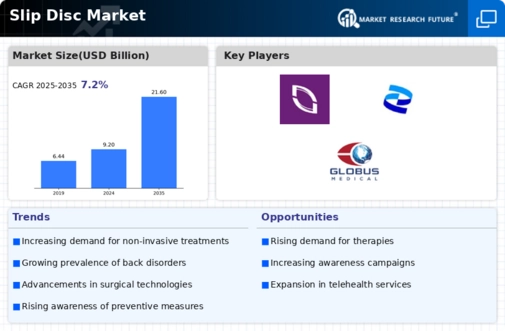Market Analysis
In-depth Analysis of Slip Disc Market Industry Landscape
The increasing recognition of non-fusion procedures for the spine
Preserving the inherent mobility of the spinal column is a significant milestone in the healthcare sector, steering away from the conventional approach of spinal fusion surgeries. Surgeons and medical innovators are actively developing devices that can be implanted to address various spinal conditions and injuries without resorting to fusion procedures. This innovative approach enables patients to retain a degree of flexibility and movement, a notable departure from the restricted mobility associated with fusion procedures. Among the array of treatments emerging in this domain, disc arthroplasty stands out as a widely adopted method, involving the replacement of a damaged disc with an artificial device designed to closely emulate the natural disc.
Recognizing the dynamic nature of the spinal column, healthcare professionals are increasingly embracing alternatives to traditional spinal fusion surgeries. The evolving landscape of medical technology and surgical innovations has led to the development of implantable devices that offer therapeutic solutions for diverse spinal conditions and injuries, all while avoiding the limitations imposed by fusion procedures.
Disc arthroplasty emerges as a prominent non-fusion treatment, gaining traction due to its effectiveness in addressing spinal issues. This procedure entails the substitution of a damaged disc with an artificial device meticulously crafted to replicate the characteristics of the natural disc. The primary advantage lies in the preservation of the patient's range of motion and flexibility, a departure from the immobilizing effects commonly associated with spinal fusion treatments. By mimicking the natural disc, disc arthroplasty not only addresses the underlying condition but also enhances the patient's overall quality of life.
The shift towards non-fusion procedures is underpinned by a desire to optimize patient outcomes and experiences. Retaining spinal mobility is crucial for maintaining a patient's daily activities and quality of life, making non-fusion procedures an attractive option for both medical professionals and those seeking spinal interventions. This paradigm shift aligns with the broader goals of healthcare industries to provide treatments that not only address the specific ailment but also prioritize the holistic well-being of the patient.
As awareness grows surrounding the benefits of non-fusion procedures, the healthcare sector is witnessing a paradigm shift in the approach to spinal interventions. Surgeons and medical engineers are at the forefront of this transformation, spearheading the development of innovative devices that offer effective solutions without compromising the natural mobility of the spine. The increasing adoption of treatments like disc arthroplasty signifies a positive stride towards a more patient-centric and nuanced approach to spinal healthcare. In the quest for improved outcomes and patient satisfaction, the trajectory of spinal interventions is veering towards non-fusion alternatives, marking a notable advancement in the field.






Leave a Comment